| MAGDALEN HILL
DOWN |
 |
Magdalen Hill Down
|
Natural chalk downland, untouched by modern agriculture, is now
rare. Renowned for its rich flora and butterflies, chalk downland
survives only in small, isolated pockets. It once encircled
Winchester, but most of it has been lost to housing, roads, golf
courses, afforestation and agriculture. These losses make what is left
very special. Magdalen Hill Down on the eastern edge of Winchester is
a fine example, now restored to its former beautiful state by the
Hampshire Branch of Butterfly Conservation.
Years ago, the hillside that now forms the Original reserve was a paradise of wild flowers and
butterflies. But by 1989 there was a heavy growth of wild privet,
dogwood, bramble and hawthorn, which threatened the delicate flowers
and the butterflies that depend on them. The scrub has now been
cleared and is kept under control: only selected thickets are retained
to give shelter and provide a habitat for birds and other creatures.
Many shrubs and trees are the larval food plants for moths.
|
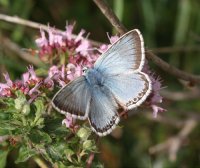
Chalkhill Blue
Photo © Peter Eeles |
|
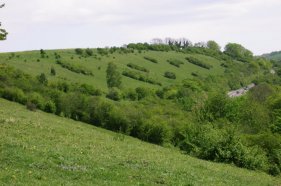
Magdalen Hill Down
Photo © Tim Norriss |
Volunteers play a vital part in the ongoing conservation work of
the reserve, including regular monitoring of butterflies, moths and
vegetation to check that the management is having the desired effect.
The reserve is also kept in good order by
grazing, mainly in autumn and winter which is why it is divided
into several enclosures. Cattle and sometimes sheep are used. Grazing conserves the mixture of fine
downland turf and the rich variety of plants upon which butterflies
and their caterpillars depend. The wild rabbit population helps to
maintain the areas of short turf that butterflies such as the Brown
Argus need. Female butterflies are very fussy about where they lay
their eggs, and the turf must be exactly the right height. Some
species need short grass while others prefer it longer. The land is
therefore managed to maintain a mosaic of habitats and turf lengths.
No artificial fertilisers are used. In agricultural terms the whole
reserve is 'unimproved grassland', but for butterflies it is paradise. |
|
Thirty-four species of butterfly have been seen at Magdalen Hill
Down, including major breeding colonies of Brown Argus, Green
Hairstreak and Chalkhill Blue.
The caterpillars of the first two feed on common rock-rose, the
latter on horseshoe vetch, and the hillside is yellow with these
flowers in summer. Various orchids occur, and later in the year the
reserve has fine displays of clustered bellflower, autumn gentian and
autumn lady's tresses.
|
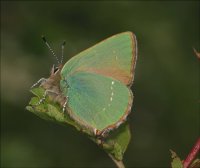
Green Hairstreak
Photo © Peter Eeles |
|
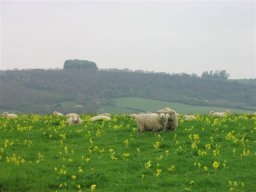
Magdalen Hill Down
Extension
Photo © Lynn Fomison |
The reserve was extended in 1995 when a further 32 acres was
acquired. This eastern area, behind Magdalen Hill cemetery, had been
intensively farmed from 1940 until 1995, with crops such as wheat,
peas and daffodils. In 1997 Butterfly Conservation sowed it with grass
seed specially gathered from other Hampshire nature reserves and
wildflower seed chosen to recreate the flower-rich grassland that once
flourished. As the years go by, more and more butterflies from the
original reserve will colonise this new area. The site will thus
provide ideas for landowners wishing to improve an area for wildlife. |
|
In 2001 the "wasp" spider, Argiope bruennichi, was found on the
reserve and it has been regularly seen since then.
|
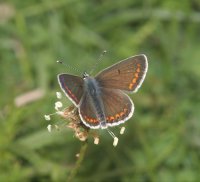
Brown argus
Photo © Peter Eeles |
|
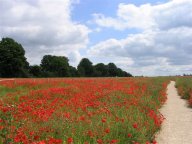
Magdalen Hill Down North
Photo © Lynn Fomison |
In 2004 a 55-acre ex arable field was added to
the reserve in a joint scheme with Hampshire County Council. The
poppies that appeared after the initial sowing have died out and
their place taken by a wide range of perennial wild flowers.
Magdalen Hill Down North affords easy access to visitors with
limited mobility having a car park accessed by a RADAR key and a
hardened path. |
There is a car park opposite the Magdalen Hill Cemetery on the
B3404 (at SU511295). See the maps below. On foot, then take the track
going directly south which leads you to the reserve entrance.
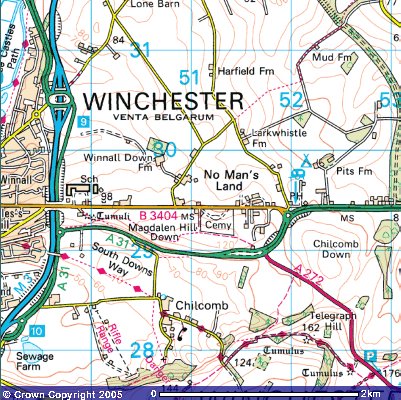
© Crown copyright. All rights reserved. Licence
number 100015237.
Image produced from the Ordnance Survey
Get-a-map service.
Image reproduced with kind permission of
Ordnance Survey and
Ordnance Survey of Northern Ireland.
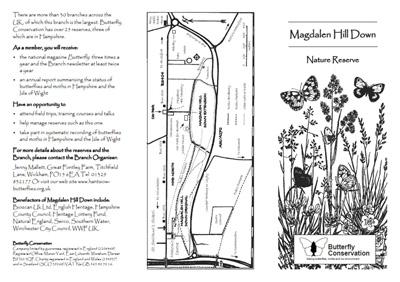
Download reserve leaflet (1025 KB pdf file)
If you do not have a PDF file reader, then click this image for a
free download:

|



